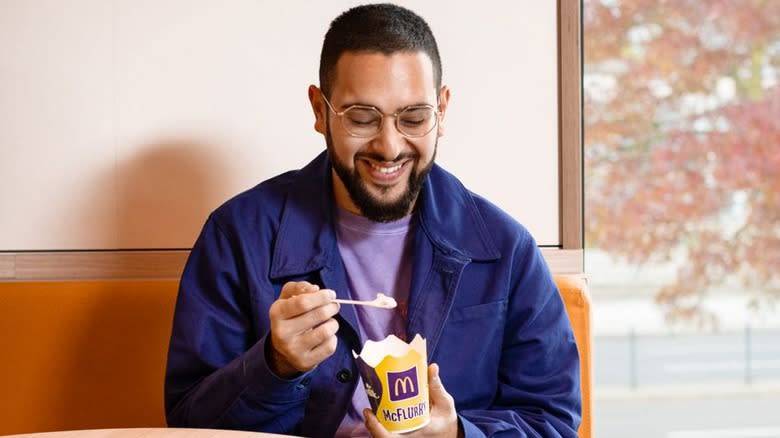With at least 41,800 locations as of 2023, McDonald’s is considered the largest fast-food restaurant chain in the world. Its global reach spans roughly 100 countries, encompassing more than 13,700 locations in the United States alone. By sheer numbers and related consumer products and packaging, that gives McDonald’s a notable impact when it comes to sustainability. That’s why the company’s recent ramp-up of sustainability measures matter, including the newly revealed reconfiguration of its McFlurry cups.
The new change in the McFlurry cup packaging focuses on the lids, formerly a separate component made of plastic. The new cup is a one-piece container with four flaps at the top enclosing the popular McDonald’s dessert, thereby ditching the conventional plastic lid. It’s all part of the company’s wide-reaching 2025 year-end sourcing goal of reaching 100% renewable, recycled or certified materials for guest packaging. That includes strategies such as eliminating unnecessary packaging and seeking out alternative materials that lower environmental impact.
McDonald’s reported reaching 86.7% of that goal by the end of 2023, and the new McFlurry packaging continues ongoing efforts. Before debuting in U.S. stores, the four-flap container appeared in international markets including Canada and Indonesia. In conjunction with the container announcement, McDonald’s unveiled a new little-sister size: the Mini McFlurry, about half the size of a regular McFlurry, for those desiring quick-bite treats in smaller portions.
Read more: 23 Best Ice Cream Brands Ranked
Reconfigured McDonald’s Materials Encompass More Than McFlurries

McFlurry containers join a parade of sustainability efforts by the fast food industry — but they aren’t the first contribution by McDonald’s. In fact, food packaging is only one target of the company’s 2025 goal for waste reduction and transformational material sourcing. The well-loved Happy Meal toys are included as well, with intent to eliminate virgin fossil fuel-based plastic in the toys. Progress in that area has already reached 63.7%.
Spoons got a lot of transformational love in 2023, with the chain bidding farewell to the hollow straw-like McFlurry spoons containing extra plastic. It was a long questioned design anyway, with the company acknowledging the confusion in a press release: “Why is the handle hollow? Is it a spoon, a straw, or both?” In reality, the design served double duty as a spindle for restaurant workers mixing toppings into various McFlurry flavors. They now come with the same smaller spoon used in McDonald’s sundaes, contributing to lower single-use plastic waste.
McDonald’s packaging commitments extend to the elimination of all intentionally added fluorinated compounds in guest packaging, a goal already reached in the U.S. market. Commonly known to the public as PFAS, the so-called “forever chemicals” in fast-food packaging have been routinely used in food wrappers to prevent the leakage of grease and liquids. Additional overarching principles behind McDonald’s goals for environmental and social impact range from science-based, net-zero climate targets to deforestation elimination, animal welfare, responsible antibiotic use, and more.
Read the original article on Tasting Table.
Source Agencies


